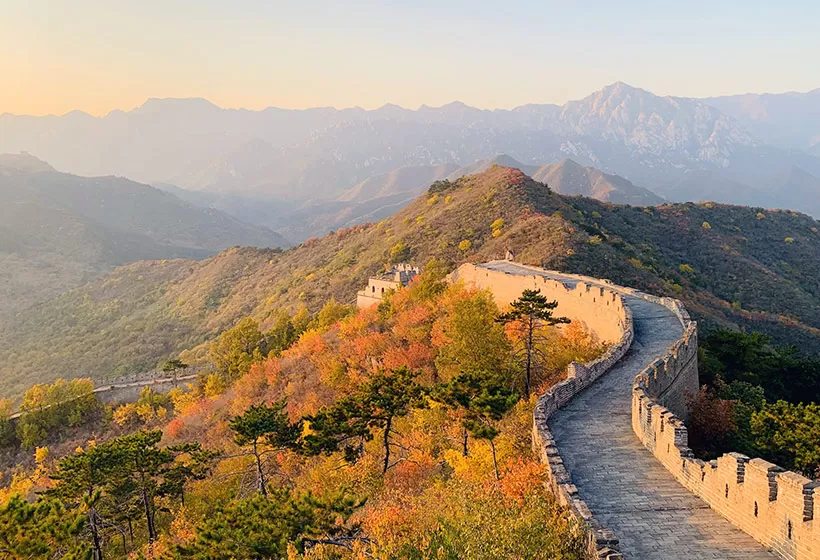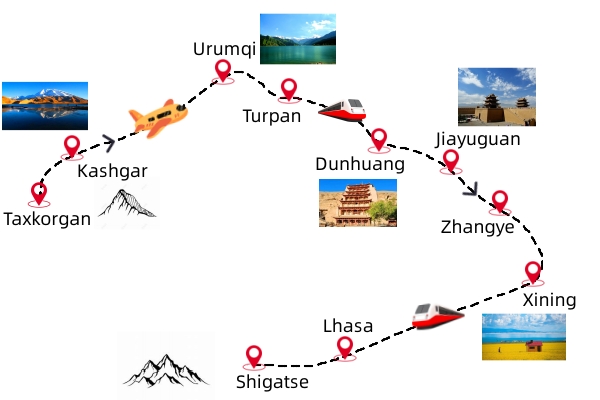1. Tips: Be aware of the eight Chinese culinary practices. Sichuan cuisine, Cantonese cuisine, Fujian cuisine, Hunan cuisine, Anhui cuisine, and Zhejiang cuisine are all major Chinese dishes. Each one has its own distinct dishes, flavors, and techniques.
Pro: Helps you plan your dining experiences according to your preferences for taste.
Con: Can be overwhelming to be able to recall the specifics of each cuisine.
2. Embrace local specialties
You should try the local cuisine, be it Peking Duck, Xiaolongbao, or Hot Pot, in Chengdu.
Pro: It ensures an authentic and culturally rich dining environment.
Con: It can limit your ability to explore different cuisines within the region you are visiting.
3. Pay attention to regional flavours
Tips Advice Sichuan food can be spicy and numbing. Cantonese dishes are light and fresh. They are also sweet and refreshing. Jiangsu is delicate and sweet. Select dishes according to spice tolerance and preference.
You can avoid ordering food that isn't your taste.
Con: Some flavor profiles might require some testing.
4. Discover Street Food
Explore the local cuisine and experiment with food items. Take a bite of local food.
Pros: Street Food is cheap, convenient, and gives an insight into the daily routine in the neighborhood.
Con: Hygiene may be a concern sometimes; pick vendors that are highly turnover.
5. Learn Basic Dining Etiquette
Tips Take note of Chinese eating habits, such as eating with your family in a traditional family manner and not sticking chopsticks straight up into rice.
Pro This displays respect for local culture, and improves your dining experience.
Cons: It takes time to adapt and learn the new rules of etiquette.
6. Find out what locals think of you from the community.
Locals are usually aware of which restaurants or dishes are best within their local area. Don't be afraid to ask for help.
Avoid tourist traps and discover hidden treasures.
Cons: Communication can be difficult due to language barriers.
7. Be open to unfamiliar ingredients
Tips: Regional cuisines can include unusual ingredients, such as bamboo shoots, lotus root, or stinky tofu. Be open to new cuisines.
Pro: Improves your understanding of Chinese culture by expanding your palate.
Cons: You might not like all the dishes or may have food restrictions.
8. Create dietary restrictions that are compatible with
Learn Mandarin phrases which are used to convey preferences and allergies.
Pro: Provides you with an enjoyable and safe dining experience customized to meet your specific needs.
Cons: Certain cuisines offer only a few options for accommodating particular dietary needs.
9. Mix regional and local drinks with your food.
Drink local beverages like tea from Fujian or Baijiu in northern China.
Pro: It improves and compliments the dining experience.
Cons: Some people may not like the strong flavors of baijiu.
10. Avoid Overordering
Tips: Chinese meals are usually served family-style. Order conservatively, and then increase when needed.
Pros • Reducing food waste. Allows you to try different dishes.
Cons: You might be tempted to buy too much due to the range.
Benefits of Experiencing the Regional Cuisines in China
Different Flavors: Enjoy an incredible variety of tastes recipes, techniques, and ingredients.
Cultural Insight : Develop a better understanding of regional identites and the underlying traditions.
The cost of local meals is reasonably priced.
Memorable experience: The taste of classic dishes at their original setting creates memories that will last for a for a lifetime.
Cons of Exploring regional cuisines in China
Concerns about hygiene: Street food and small restaurants may not meet the standards of hygiene set by international standards.
Language Barriers. Menus or explanations in Mandarin may make it difficult to take orders.
Certain flavors or textures can be difficult for some people.
Some areas have strict dietary restrictions for vegetarians, vegans or those with food allergies.
If you adhere to these guidelines and are a little adventurous then you'll be able to explore the many delicious regional Chinese dishes while navigating all the difficulties. Take a look at the top discover more about this attraction for site advice including anren ancient town, naked marriage in china the most fashionable wedding style for the 1980s, entertainment in hong kong, xi an travel tips, china built the worlds deepest high speed railway station under the great wall, shaoxing wine the best yellow wine in china, chaotianmen dock%EF%BC%8C a major water transportation hub in chongqing, xishuangbanna, four gentlemen in chinese culture, shopping in dunhuang and more.

Top 10 Tips To Visit Chinese Temples And Avoid Fees
1. Fees for Entertainers: Many famous temples charge a fee to enter, which can be as high as Y=20 to 200 Y. You can plan your budget when you study the prices of tickets.
Pro can help you avoid surprises and ensure you have the correct amount of cash or digital payment.
Con: Unexpected additional expenses, such as special charges for exhibits, can arise.
2. Bring Cash or a Digital Payment
Certain temples only accept cash, or more popular Chinese payment methods like WeChat Pay or Alipay.
Pro: Smooth entry with no payment delays.
Cons: There are a few options for foreigners who do not know how to use digital payment apps.
3. Be on the lookout for signs that refer to photography.
Look for signs that tell you whether or not photography is allowed. There are many temples that prohibit photography in the sanctuaries of sacred artifacts or inside sanctuaries.
Pro: It stops accidental infractions or violations of rules.
Cons: The rules could differ in different parts of the temple. This requires extra care.
4. Avoid Flash Photography
Tip: Avoid flash photography in places that permit photography. Flash may cause damage to artifacts and disrupt worshippers.
Pro: Protects and improves the temple’s environment.
Con: Low-lighting may result in less-than-ideal photos.
5. Respect, Worshippers Privacy
A suggestion: Don't photograph people performing religious rituals, or praying, without their permission.
Pro: Shows the sensitivity to culture and respect for personal space.
Con: It could restrict your ability to capture the ambience of the temple fully.
6. Follow Drone Regulations
Tips - Drones are generally prohibited in temples. If you plan to make use of a drone for photography from the air, you should check the local laws.
Pro -: Avoid paying fines or confiscation.
Cons: It reduces the possibility of capturing unique angles.
7. Be prepared for the possibility of additional charges
You may be charged extra by certain temples to allow you to shoot photos, especially in the case of professional equipment, such as DSLRs or tripods.
Pro: You can create photographs of high-quality legally.
Cons: It increases overall trip cost
8. Dress modestly
Tips: Respectful attire is important in temples. Inappropriate clothing could lead to being denied entry or a refusal.
Pros: Displays respect to the sacred setting and helps you to blend in.
Con: May require additional preparation, especially during the summer heat.
9. Beware of crowds when taking Photographs
Tips: Try to go early in the morning or in the late afternoon to be able to avoid crowds. It is easier to get better pictures with less obstruction.
Enhances your photographs and experiences.
Cons: This might need you to change your schedule. It is not always convenient.
10. If you are unsure, Request Permission
Consult the temple staff and signposts regarding rules when you're in doubt.
Pro: You'll be able to prevent unintentionally breaking rules.
Con: Language barriers might make communication difficult.
The advantages of adhering to the rules of photography and fees
Cultural Respect Affirmation of local customs and religion.
Artifact Protection: Guard fragile artifacts and structures from the possibility of damage.
Positive Experiences : Avoid confrontations between temple staff members or worshippers.
Legal Compliance: Protects against penalties or fines in the event that you break photography rules.
Cons of Keeping Fees and Photography Rules
Increased Costs: Additional fees for entry and photography permits can add up.
Restricted Creativity: Limitations can hinder the ability to get the perfect photo.
Language Barriers. Problems communicating or understanding local signs.
It requires more time and effort to prepare for the research project.
By adhering to the rules and fees regarding photography will ensure you will have a pleasant, respectful and lawful trip to China's beautiful temples, while preserving their sacred and cultural integrity. See the top check out this top tourist destination for site advice including eating in guilin, zhangjiajie tour maps, great tang all day mall xian.html, eating in urumqi, jinan transportation, the top 4 movies about kung fu and chinese culture, tips for identifying copyright, wang zhaojun one of the four beauties in ancient china, chaotianmen dock%EF%BC%8C a major water transportation hub in chongqing, the color of dress in china and more.
